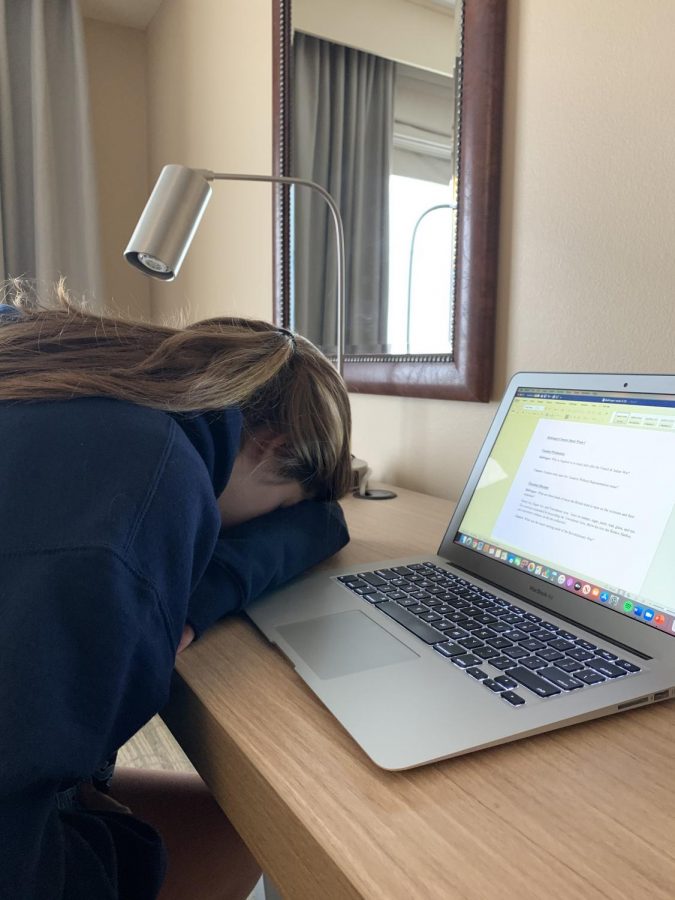Students’ Health is Being Put at Risk Everyday of Virtual Learning
A glimpse into the student side of online learning.
Students are struggling with online learning more than you may think.
Everyday, students are struggling to maintain both their mental and physical well-being while proceeding with virtual learning. Students are now expected to keep their grades up, take care of their younger siblings, and still find time to go outside.
In an article on Psychology Today, Randy Kulman, Ph.D., a child clinical psychologist, says that children shouldn’t spend more than around three hours on an electronic device. He provides the phrase “play diet” to convey the balance of a child’s social, physical, creative, unstructured, and digital play.
“Clearly, there are many benefits of digital play for children, yet excessive amounts are problematic in terms of physical, social, and emotional health issues,” says Kulman.
The problem with virtual learning isn’t necessarily the amount of time students are staring at a screen, it’s the fact that screen time is outweighing every other necessity by grand proportions. When students would be actively moving about their classrooms or collaborating with classmates in person on an assignment, instead they aren’t receiving nearly the same physical and social exercise.
In addition, students are being forced to take on roles that they otherwise wouldn’t be doing if they went to school in person, such as taking care of younger siblings and keeping up with daily household chores. Countless parents and guardians have to work extra shifts to compensate for the economic change caused by the pandemic, and in many families, children aren’t left a choice in the responsibilities they have to take on.

A social worker out of Newport News who wishes to remain anonymous due to security reasons encounters students everyday who are struggling to uphold their grades and attendance record while helping their siblings with their homework. She also explains how communication with these students is a lot more difficult online than in person. In other instances, students are working out of hotels or homes with spotty WiFi, and although attempts to increase WiFi coverage across the county have been made, this still isn’t enough to maximize student learning.
She believes it is vital to transition back into online learning for those students that are having the most difficulty with virtual school.
“It’s time to begin that process [of going back to school in person] for our most vulnerable students. Whether that is ESL, students with special needs, and our young learners in pre-K to third grade,” she says.
Throughout all of these difficulties, teachers are continuously coming up with ways in which students can socialize and work with classmates. However, speaking to a blank screen on a computer is a lot different than communicating in person.
As students aren’t required to turn on their cameras during zoom meetings, no one does due to the impending social doom that would ensue. In the world of a teenager, typically participating in class is frowned upon unless someone is willing to break the ice upfront. In a more personal setting than Zoom, this is much easier and much more common. However, after a month of being all-virtual, the ice that is teenage awkwardness is still very very thick.
Speaking in class is uncomfortable, but a joyride in comparison to breakout rooms. If you are unfamiliar, teachers often impose the task of “working with your classmates” as a way for students to get to know their peers and hopefully understand the curriculum in a different way. They are able to split students up into groups, just as they would do in person. However great this seems in theory, the reality of it is unpleasant. Students are still reluctant to turn on their cameras, and the ability to just put yourself on mute and make a quick snack run to the kitchen is right at your fingertips.
On that note, teachers have learned the hard way that punishment is not easy to give. Students have more freedom online than in person, and, while that is in the front of every student’s mind, it is still sometimes impossible for teachers to catch everything. Conversation in breakout rooms are impossible to enforce, therefore students tend to take the liberty to relax for those quick four minute “breaks.”
The irony in this is that in class, students aren’t just forced to talk in small groups, they are usually beside themselves with excitement to talk about anything. The online version of school has diminished welcome socializing. No matter how hard everyone tries, students just cannot use school as a social outlet anymore.
Because of this, teenagers are lacking in the social aspect of their lives and are suffering because of it. In an age where rates of depression and anxiety are increasing among teens, virtual school cannot be the best option for long.
(Students only) Would you rather be doing school in person or virtually right now?
- In person (75%, 3 Votes)
- Virtually (25%, 1 Votes)
Total Voters: 4
(Parents only) Is your child (or children) experiencing more stress and anxiety learning online than they would in person?
- Not really (67%, 2 Votes)
- Yes (33%, 1 Votes)
Total Voters: 3
Do you believe we should go back to school in person anytime this year, regardless of the severity of the pandemic?
- Yes (60%, 3 Votes)
- No (40%, 2 Votes)
Total Voters: 5




